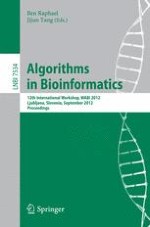This book constitutes the refereed proceedings of the 12th International Workshop on Algorithms in Bioinformatics, WABI 2012, held in Ljubljana, Slovenia, in September 2012. WABI 2012 is one of six workshops which, along with the European Symposium on Algorithms (ESA), constitute the ALGO annual meeting and focuses on algorithmic advances in bioinformatics, computational biology, and systems biology with a particular emphasis on discrete algorithms and machine-learning methods that address important problems in molecular biology. The 35 full papers presented were carefully reviewed and selected from 92 submissions. The papers include algorithms for a variety of biological problems including phylogeny, DNA and RNA sequencing and analysis, protein structure, and others.
